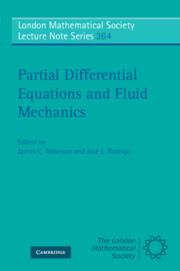Book contents
- Frontmatter
- Contents
- Preface
- List of contributors
- 1 Shear flows and their attractors
- 2 Mathematical results concerning unsteady flows of chemically reacting incompressible fluids
- 3 The uniqueness of Lagrangian trajectories in Navier–Stokes flows
- 4 Some controllability results in fluid mechanics
- 5 Singularity formation and separation phenomena in boundary layer theory
- 6 Partial regularity results for solutions of the Navier–Stokes system
- 7 Anisotropic Navier–Stokes equations in a bounded cylindrical domain
- 8 The regularity problem for the three-dimensional Navier–Stokes equations
- 9 Contour dynamics for the surface quasi-geostrophic equation
- 10 Theory and applications of statistical solutions of the Navier–Stokes equations
10 - Theory and applications of statistical solutions of the Navier–Stokes equations
Published online by Cambridge University Press: 07 September 2011
- Frontmatter
- Contents
- Preface
- List of contributors
- 1 Shear flows and their attractors
- 2 Mathematical results concerning unsteady flows of chemically reacting incompressible fluids
- 3 The uniqueness of Lagrangian trajectories in Navier–Stokes flows
- 4 Some controllability results in fluid mechanics
- 5 Singularity formation and separation phenomena in boundary layer theory
- 6 Partial regularity results for solutions of the Navier–Stokes system
- 7 Anisotropic Navier–Stokes equations in a bounded cylindrical domain
- 8 The regularity problem for the three-dimensional Navier–Stokes equations
- 9 Contour dynamics for the surface quasi-geostrophic equation
- 10 Theory and applications of statistical solutions of the Navier–Stokes equations
Summary
Abstract
Since the 1970s the use of statistical solutions of the Navier–Stokes equations has led to a number of rigorous results for turbulent flows. This paper reviews the concept of a statistical solution, its role in the mathematical foundation of the theory of turbulence, some of its successes, and the theoretical and applied challenges that still remain. The theory is illustrated in detail for the particular case of a two-dimensional flow driven by a uniform pressure gradient.
Introduction
It is believed that turbulent fluid motions are well modelled by the Navier–Stokes equations. However, due to the complicated nature of these equations, most of our understanding of turbulence relies to a great extent on laboratory experiments and on heuristic and phenomenological arguments. Nevertheless, a number of rigorous mathematical results have been obtained directly from the Navier–Stokes equations, particularly in the last two decades.
Of great interest in turbulence theory are mean quantities, which are in general well behaved, in contrast to the corresponding instantaneous values, which tend to vary quite dramatically in time. The treatment of mean values, however, is a delicate problem, as remarked by Monin & Yaglom (1975). In practice time and space averages are the most generally used, while in theory averages with respect to a large ensemble of flows avoid some analytical difficulties and have a more universal character.
- Type
- Chapter
- Information
- Partial Differential Equations and Fluid Mechanics , pp. 228 - 257Publisher: Cambridge University PressPrint publication year: 2009
- 1
- Cited by



